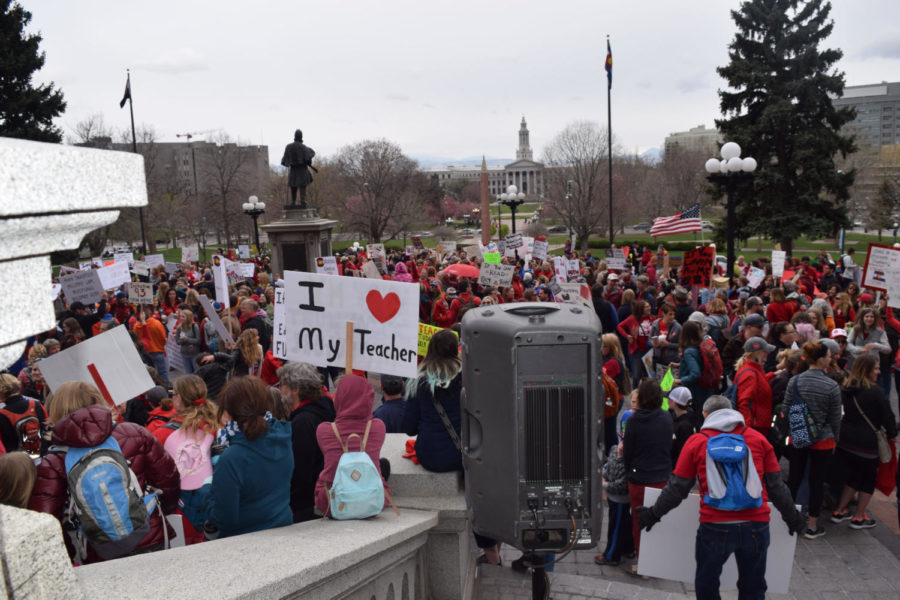Teachers Paint State Capitol Red
Educators and their supporters rally at the state Capitol April 26 for increased education funding and a secure retirement fund.
May 10, 2018
Following in the footsteps of Kentucky teachers, educators from Jefferson, Lake, Clear Creek, Douglas, and Eagle counties marched on the Capitol on Thursday, April 26.
More than 2,000 teachers from these five school districts met together to simultaneously protest what they see as the dismal situation of Colorado school funding and to show support for the House Finance amended version of Senate Bill 200, along with other education bills being voted on. Teachers joined together on the Capitol steps along with parents, students, and other education advocates to protest. Wearing red and waving signs, they began the day with learning chants. Among these were, “Who’s schools? Our schools!” “Schools need libraries! Schools need books! Schools need money that Wall Street took!” and, “This is what democracy looks like!”
Educators and their supporters gave their opinions on why they were there. One such education advocate was Lisa Elliott, the UniServe Director at the JCEA (Jefferson County Education Association) office. She was at the Capitol “advocating for students to have a better education,” and also stressing the importance of increased funding because as it stands, “teaching pays so little.”
The ideal goal, said Elliott, would be acquiring “more funding to get Colorado out of the bottom five states for per-student funding.” More realistically, she hoped that this and other days of action would at least “get the attention of legislators,” and of the community. Since only 30% of voters in the Denver-Metro area have school children, civic action such as the rally on the 26th will hopefully bring these issues further into the public light.
Elliott also communicated her hopes for Initiative 93. This initiative, which the teachers hope will become an amendment, primarily deals with raising money for public education. That money, if the amendment passes, would be taken from “those who make more than $153 thousand a year,” and thus would have little or no effect on the vast majority of voters. Other goals of the initiative include “stabilizing property taxes,” (which would result in “a long run increase” of education funding) by readjusting the Gallagher Act. Advocates of this initiative are seeking voters’ signatures to get it on the ballot. Once on the ballot, it will need to be approved by voters in a general election.
At the Capitol, educators were also encouraged to write their personal stories and opinions on education and send them to their legislators on the floor. Many of the educators also held a “grade-in” inside the Capitol where they graded papers in order to give their legislators a glimpse of their workload.
During this time, while the Senate, House, and other committees met, teachers flowed in and out of the building. At 1:00, the teachers marched once again, this time going all the way around the block. Passing cars honked in support, and teachers cheered, chanted, and waved their signs as they demonstrated their democratic rights. Several local groups performed shortly after this, entertaining the teachers until the speeches started at approximately 1:40 p.m.
Kerrie Dallman, President of the CEA, spoke, as did teachers from some of the different counties present. Besides these teachers and other supporters, state senator Andy Kerr spoke, representing the “pro-education” legislators. A recurring theme in all of these speeches was the fact that teachers have done “more with less” for long enough, and that to do any more they would need more. The speeches culminated with Wheat Ridge High School’s own social worker, Pamelagrace Okeke’s presentation, including a fiery message, calling out to the legislators in the building, and climaxing in a impassioned acapella rendition of Tracy Chapman’s “Talkin’ ‘bout a Revolution.”
On Friday April 27, around 6,000 teachers overtook the Capitol as more educators spent their second day with the same goals in mind. This day, teachers came from Denver Public Schools, Cherry Creek Schools, and many other districts from around the state. On that Friday, CEA also took a group of three teachers to meet with both Governor John Hickenlooper and Lieutenant Governor Donna Lynne. The teachers were from a variety of districts and spoke of the difficulties they’ve encountered in the classroom as a result of insufficient education funding.
Amanda Hawkins, a high school special education teacher at a school near Colorado Springs, spoke of the difficulties of teaching without resources. Hawkins works in a school with a high proportion of students on free and reduced lunch, and she finds it, “Hard to meet kids’ academic needs while their other needs are not getting met.”
A chemistry teacher from Sheridan High School, Karen Babcock, fears that some of her students are falling behind because, “They have had [some] unqualified… teachers for three years. Trying to attract talent to our have-nots is almost impossible in an urban area.”
The third teacher there was an elementary special education teacher in the Cherry Creek district, Jennie Campbell. Even though she teaches in what is considered a more affluent and funded district, she, too, experiences limitations in what she can do for her students. Between meeting with parents and administering tests, Campbell was unable to meet much more than eight minutes a day with each kid. “When am I going to give these kids the education they need?” she asked after going through her exhaustive schedule.
Both Hickenlooper and Lynne were receptive to the the difficulties that come with the profession. “Personally, what you do really matters to me,” said Lynne. She also made it clear to the teachers that, “It’s not the individual teachers that caused the [PERA] problem. Those were decisions we made in this building.”
Though the future of PERA, education funding, and Initiative 93 are currently up in the air, educators made their concerns heard over those two days. Hickenlooper summed up the spirit of the marches when he said, “[The] very best protests have a certain level of anger, and vigor, and joy. That looked pretty successful.”



